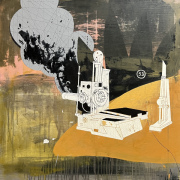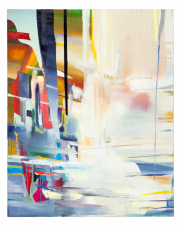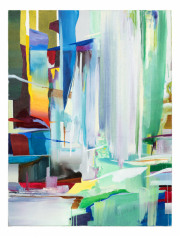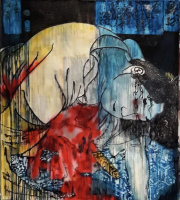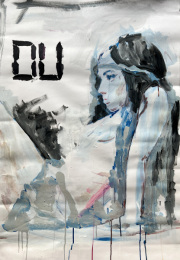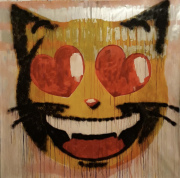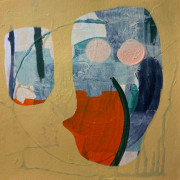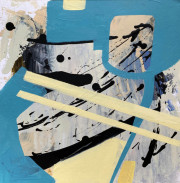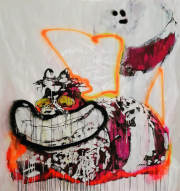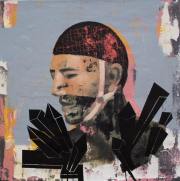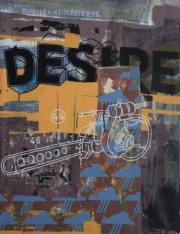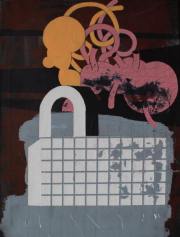„Ghosts of Color“
Florian Fausch, Hannah Jones, Lisa Kränzler, Juan Miguel Pozo, Guido Schulz
July 7th – August 26th 2023 (the gallery is not open between August 15th – 21st)
Opening: July 7th, 6 – 8 pm
janinebeangallery presents in its summer exhibition abstract and figurative painting and photography. The artworks originate from varying contexts, materials and artistic spheres. They are united by a passion for intense colors and contrasts.
Florian Fausch’s images are utopian architectural landscapes that follow rules of their own; they are places and non-places all at once, revolving around the concept of the image. Clear-cut sharp lines define architectural elements that in turn disappear into immaterial motifs. This creates a simultaneity of different levels and painting styles. The angular forms are reminiscent of the collage or stencil cutting techniques used for geometric compositions.
His paintings walk a fine line between abstraction and figuration. In the course of his artistic development Fausch—who used to paint figurative landscape paintings during his studies—made his subjects more and more unrecognizable, without ever completely negating them. At the beginning of every picture there is a concrete framework in the form of a photograph, be it from the artist’s collection, the Internet, a magazine, a computer game, or something similar. As a person who grew up with new forms of media as a matter of course, Florian Fausch uses the ubiquitous flood of images in his search for motifs. Through drawing, he combines inspiration from the world of print and online media with his own ideas. For Fausch, the drawings serve as a form and an opportunity to formulate and capture thoughts. At this stage, and even more intensively during the painting process, he gives free rein to thoughts and motifs, allows them and even urges them to take on a life of their own. If one looks at the pictures from a certain distance, one almost detects something like a painted collage or a collaged visual narrative, which reflects our reality in its diversity. But the resulting imagery always toys with the memory of reality more than with reality itself.
Florian Fausch studied painting at the Düsseldorf Art Academy with Prof. Siegfried Anzinger. He lives and works in Düsseldorf.
Hannah Jones is a painter born in 1990 in Wales, who lives and works for several years now in Berlin. She has already exhibited internationally in Berlin, Paris, New York and Greece, among other places.The paintings created by Hannah Jones are characterized by a rhythmic flow that allows the viewer to follow this course, developing an individual view of the artist’s work.
Jones’ artworks are characterized by a unique synthesis of colors, shapes and rhythms. She finds in abstraction the freedom to express her creative vision without being bound by realistic conventions. In her artistic work, Hannah Jones draws inspiration from many sources. In her visual arts, it is abstract painters such as the American artist Amy Sillman, but also artists of her own generation such as Danielle Mckinney and Beverly Renekouzou. She is also concerned with an exploration of the female perspective in art and the creation of artworks that establish a connection between creation and destruction.
Lisa Kränzler, born in Ravensburg in 1983, studied painting and graphic arts at the Karlsruhe Art Academy since 2005. In 2012 she completed her studies as a master student under Tatjana Doll. The artist has also been active as a writer since 2012 and has achieved remarkable success with her novels.
In the field of visual arts, she devotes herself to painting and drawing. Kränzler creates her large-format representational paintings, entirely from paint, whereby the proximity to the cartoon is clear. She uses varnish, a conventional painting color, which she applies to paper. “As far as painting is concerned, Kränzler is preoccupied with undermining its convention. She pursues this preoccupation with impudence and ruthlessness, but without naiveté.” Her drawings can be seen as a connecting element between visual art and writing, “as in them there is a constant jumping back and forth between texts and images, applied colors and typewritten letters, or the visible and the legible.” (Quotes: Ulrich Loock 2016)
Juan Miguel Pozo was born 1967 in Holguin, Cuba. During his time as an art student at the University of Havana a German journalist discovered him in 1994, drawing the attention of friendly artists like Konrad Klapheck on the Cuban painter. These artists advocated for Pozo‘s scholarship at the Art Academy Düsseldorf in Germany, enabling him to emigrate to Europe. The artworks of Juan Pozo are part of such renowned international art collections as Ella Fontanals Cisneros, Pérez Art Museum Miami (PAMM), Falckenberg, Ludwig, Nachmann and Sean Penn and many more.
In the images of the paintings not only places like Berlin and Havana are assembled but also the essences of utopia and dystopia. In front of monochrome, more or less abstract geometric basic shapes urban architechtural objects float in the foreground, i.e. they lack ground or foundation, whole pieces of land seem to be suspended in space like components of model kits. Though apparently the result of an urban building plan but without an identifiable purpose for inhabitants other urban elements like staircases appear non-attached in space. Through techniques like abrading and scraping all objects in the images seem worn and aged, in addition there are incomplete or abstract areas and runny colors on the fringes. The motifs thereby overall appear rough and marked by gradual decay.
Juan Miguel Pozo‘s paintings connect everyday artificiality as a feature of dogmatized utopias with their inherent structural weaknesses and their result in disintegration and collapse. For Pozo these experienced processes, respectively periods of time are one entity, the ideologic vision inheres its own demise as well as a social ruin bears the retention and gain of a cultural essence. Herein substantiates the title of the exhibition, because the future was a place, an idealized topos of the past, which is unable to stand the temporal dynamic of the actual present without disruption.
Guido Schulz is not only the manager of the DJ-legend Westbam and of the German hip-hop institution Bass Sultan Hengzt, but also constitutes an outstanding figure in the music business since the eighties. As a veteran of the music branch and former head of the A&R department of Sony BMG as well as A&R director of BMG Publ. he was responsible for the production of numerous hits. In 1994 he then moved to Berlin where he founded the label and publishing company No Limits.
On his ways inbetween appointments and concerts Guido Schulz at some point began to take p hotos of everyday moments as well as of particular visual impressions. Rather unpretentious with his not so up-to-date cell phone he follows the principle: the best camera is the one present. From these common instants, to astonishing stills of social life to magnificent architectural observations Guido Schulz’s art of photography may only superficially be perceived to emerge in passing.
Benjamin von Stuckrad Barre about the photographies by Guido Schulz:
„We see and mourn: the volatility and evanescence, the melancholy of the metropolis, the inward rural life, the seductions of the night, the revenge of the day, the majestic neon lights, the strict geometry of the refuges and meeting points in the infinite; the beauty of the dilapidated.
And then of course we also have to laugh – about it.“

